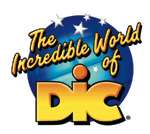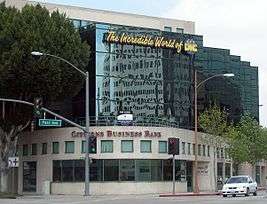DIC Entertainment
 | |
| LLC | |
| Industry | Animation |
| Fate | Folded into Cookie Jar Group |
| Successor | Cookie Jar Group |
| Founded | 1971 |
| Founder | Jean Chalopin[1] |
| Defunct | August 2008 |
| Headquarters |
Burbank, California, U.S. Former Headquarters: Paris, France |
Key people | Andy Heyward (Chairman & CEO)[2][3] |
| Products | Children's television shows |
| Parent | DHX Media |
| Website |
www |
DiC Entertainment (pronunciation: /ˈdik/[4]) was an international film and television production company. The company was also known as The Incredible World of DiC, DiC Audiovisuel, DiC Enterprises, DIC Animation City and DIC Productions at various times in its history. In 2008, DIC was acquired by the Cookie Jar Group and was folded into it. Most of the DIC library is currently owned by DHX Media after DHX acquired the Cookie Jar Group in October 2012.
In addition to animated and live-action television shows such as Inspector Gadget (1983–1986), Heathcliff (1984–1988), Dennis the Menace (1986–1988), The Real Ghostbusters (1986—1991), The Super Mario Bros. Super Show! (1989–1990), Captain Planet and the Planeteers (1990–1996), Madeline (1993, 1995, 2000–2001), Sonic the Hedgehog (1993–1994), Sabrina: The Animated Series (1999–2000), Liberty's Kids (2002–2003), Super Duper Sumos (2002–2003), Strawberry Shortcake (2003–2008), and Trollz (2005–2006), while under Disney, DIC produced live-action feature films, including Meet the Deedles (1998) and Inspector Gadget (1999), and licensed various anime series such as Sailor Moon, Saint Seiya, and Speed Racer X.
History
DIC Enterprises
Diffusion, Information Commercial (DIC) was formed in 1971 by Jean Chalopin as the production division of Radio Television Luxembourg, a long existing media company.[5][6]

DIC's American arm was founded in April 1982 in Burbank, California by Andy Heyward, a former story writer at Hanna-Barbera,[6] to translate DiC productions into English. The company produced television animation for both network broadcast and syndication, outsourced its non-creative work overseas, enforced anti-union policies and hired staff on a per-program basis to cut costs.[5] For some in the industry, DIC stood for "Do It Cheap".[5] With director Bruno Bianchi, Chalopin and Heyward were able to make DIC an effective but restrained animation company.[5]
Soon after joining DIC, Heyward developed Inspector Gadget, which became a successful production out of the American office.[5] DIC partnered with toy makers and greeting card companies for character based product lines that could be made into animated series. Thus DIC productions came with built in advertisers and some time financiers.[6] Between Inspector Gadget and The Littles (the latter produced for ABC), the company became profitable.[7]
As the only non-union animation firm, in 1984 DIC faced a unionization effort which failed.[2] In 1985, DIC opened its own Japan-based animation facility for animation production on their shows in order to bypass overseas animation subcontractors. In April 1986, DIC launched a syndicated block called Kideo TV[5] with LBS Communications and Mattel.[8]
From late 1986 to 1987, Heyward, along with investors Bear Stearns & Co. and Prudential Insurance Co, bought Chalopin and Radio Television Luxembourg's 52% stake in DIC in a $70 million leveraged buyout[2][7] and made the US headquarters the company's main base of operations.[9] After the buyout, Chalopin, Bianchi and producer Tetsuo Katayama left the company to be replaced by Robby London and Michael Maliani as key employees.[5] After selling his shares in DIC, Chalopin formed the company C&D (Créativité et Développement) in 1987 and continued to make animated shows during the late 1980s and the 1990s.[10]
After the buyout, DIC was heavily in debt and the foreign rights to the DIC library were sold in 1987 to Saban Productions, who then sold the rights to Chalopin's C&D.[1][5] At the time, Heyward considered Chalopin an enemy because of the purchase and the situation permanently poisoned their relationship.[1] DIC sued Saban for damages; in 1991, both companies reached a settlement.[1][5]
By 1987, DIC Enterprises' parent company was known as DiC Animation City, Inc.[2][11] DIC also entered the toy industry with the development of the Old MacDonald talking toyline. In December, DIC arranged a deal to merge with Computer Memories Inc., a former computer component manufacturer and then public shell company.[2] A dissident Computer Memories shareholder scudded the deal in February 1988.[7]
With the buyout debt still a burden which increased the need to produce hit shows and the animation market beginning to soften with the rise of video tape viewing, a glut of new shows and new kids cable channels, Japanese contract animation companies rates increased 40% from 1986 to 1988 due to the yen exchange rate. In 1987, DIC moved production of Dennis the Menace to a Canadian animation firm for grants and tax breaks from the Canadian government. The company started moving some work to Korea and Taiwan. By the 1987-1988 season, DIC had shows on all three major networks Saturday mornings: six half-hours of shows and 50 half-hours per week in syndication.[7]
Prudential Insurance Co. purchased additional equity of DiC Animation City in August 1989 while increasing DIC's debt capacity. For the 1989-1990 season, DIC provided 30% of the networks' Saturday morning schedule with a total 60 hours per week on networks, local stations and cable channels. Four new programs debuted that season on cable and syndication.[11]
ABC subsidiary
In 1993, DiC Animation City and Capital Cities/ABC formed a joint venture called DIC Entertainment L.P.[12] with Heyward retaining a small ownership stake.[9] With ABC in 1994, DiC programmed two children's blocks, Dragon Club and Panda Club, in China.[13] In 1996, DIC became a subsidiary within The Walt Disney Company conglomerate, following Disney's acquisition of Capital Cities/ABC.[9]
DIC launched a direct to video division in April 1998 with Riley Katherine Ellis, a Caravan Pictures producer, hired as division head. The first release planned was Madeline in spring 1999 with all the division's DVD to be released by Buena Vista Home Entertainment.[14] In May 1998, DIC agreed to provide a children's programming block, Freddy's Firehouse, to soon to be launched Pax Net.[15]
Independent
In 2000, with an investment by Bain Capital and Chase Capital Partners, Heyward re-purchased DIC Enterprises.[9][16] He purchased Bain Capital's interest in 2004 and took the company public the following year.
In January 2003, DIC announced three syndicated children's programming E/I blocks called DiC Kids Network.[17][18] While in July, DIC Entertainment signed with POW! Entertainment on a TV series production deal starting with Stan Lee's Secret Super Six, about alien super powered teens taught by Lee about humanity.[19]
In 2005, Mexico City-based Ánima Estudios was considering a partnership with DIC Entertainment. However, the latter studio wanted to focus independently on its own projects.[20]
DIC Entertainment, KOL (AOL's kids online) and CBS Corporation agreed to a new 3-hour long programming block for Saturday mornings on CBS called KOL Secret Slumber Party, which was launched on September 15, 2006.[21] On September 15, 2007, a new programming block KEWLopolis premiered, a joint venture between DIC, CBS, and American Greetings.[22]
In April 2007, DIC Entertainment, Nelvana and NBC Universal Global Networks announced plans to launch KidsCo, a new international children's entertainment network.[23]
Cookie Jar Group/DHX Media
On June 20, 2008, it was announced that DIC Entertainment would be acquired by Cookie Jar Group.[24] The deal was completed on July 23, 2008 and the company was immediately folded into Cookie Jar Entertainment.[25] Cookie Jar was in turn acquired by DHX Media on October 22, 2012.[26]
Programming blocks
- DiC Kids Network – a set of three syndicated children's programming E/I blocks announced in January 2003[17][18]
- Chinese blocks with ABC:[13]
- Dragon Club (1994–)
- Panda Club (1994–)
- CBS broadcast blocks, both with one additional partner
- KOL Secret Slumber Party – a 3-hour long block launched on September 15, 2006 with partner KOL (AOL's kids online)[21]
- KEWLopolis – On September 15, 2007, a new programming block with partner American Greetings.[22]
Freddy's Firehouse
Freddy's Firehouse (FFH) was a children's educational programming block produced by DIC Entertainment and distributed by Buena Vista International, both Disney affiliates in May 1998. At the block's start, most of the programming would be from DIC's library and was planned to air on Pax Net for two years with it running on weekends with three hours on Saturday and two hours on Sunday. Buena Vista would be free to sell to other outlets international.[15][27] However, Pax went with its own Cloud 9 block.[28]
Kideo TV
Kideo TV was a programming block by DIC with LBS Communications and Mattel.[5] Metromedia stations agreed to carry the block by January 1986.[8] Kideo TV was launched in April 1986.[5][8] Series in the block were Rainbow Brite, Popples and Ulysses 31 plus The Get Along Gang reruns.[5]
Productions
References
- 1 2 3 4 Bruick, Connie (2010-05-10). "The Influencer". The New Yorker. Retrieved 2016-01-27.
- 1 2 3 4 5 Adelson, Andrea (1987-12-30). "BUSINESS PEOPLE - For Maker of Cartoons, A Chance to Go Public". NYTimes.com. Retrieved 2016-01-27.
- ↑ Pfanner, Eric (2006-02-19). "Underdog takes shot at giants in kids television". NYTimes.com. Retrieved 2016-01-27.
- ↑ "The Revised History Of DiC, 1983-2003". YouTube. 2007-01-15. Retrieved 2015-10-12.
- 1 2 3 4 5 6 7 8 9 10 11 12 Perlmutter, David (2014). America Toons In: A History of Television Animation animation. pp. 207–212. ISBN 9780786476503. Retrieved 27 January 2016.
- 1 2 3 Bates, James (December 29, 1987). "DIC, Computer Memories Plan Merger: Cartoon Maker Seeks Easy Way to Go Public". Los Angeles Times. Retrieved May 19, 2016.
- 1 2 3 4 Bates, James (March 8, 1988). "Huge Debt Keeps Pressure on DIC to Keep Turning Out Animated TV Hits: Cartoon Firm Deals Way to Top". Los Angeles Times. Retrieved May 19, 2016.
- 1 2 3 "The Hot Team. The Hot Programs. The New Hot Weekend Network for Kids." (PDF). Broadcasting (LBS ad). January 6, 1986. pp. 8–9. Retrieved May 19, 2016.
- 1 2 3 4 Carl DiOrio (2000-09-18). "Bain backing buyout of DIC". Variety. Retrieved 2016-01-27.
- ↑ "Deltec International Group". Isola Capital. Retrieved 2016-01-27.
- 1 2 "Prudential Increases Stake in DIC Animation City". Los Angeles Times. August 22, 1989. Retrieved May 19, 2016.
- ↑ Brian Lowry (1993-07-26). "DIC Ent. formed for kids TV fare". Variety. Retrieved 2016-01-27.
- 1 2 "ABC, DIC target children in China; two-form programing venture to create kids programing channels there". HighBeam Business. 1994-08-22. Retrieved 2016-01-27.
- ↑ Jackson, Wendy (April 1998). "DIC Is Developing Direct-To-Video.". Animation World News (Issue 3.1). Animation World Network. Retrieved July 2, 2016.
- 1 2 "Toon Disney Launch - UPN To Air Disney Block". Awn.com. Retrieved 2016-01-27.
- ↑ Charles Lyons (2000-11-19). "DIC plays new toon". Variety. Retrieved 2016-01-27.
- 1 2 Lily Oei (2003-01-28). "DIC offers kidvid blocks". Variety. Retrieved 2016-01-27.
- 1 2 Lily Oei (2003-08-12). "DIC sets 3 hours of kid programs". Variety. Retrieved 2016-01-27.
- ↑ DeMott, Rick (2003-06-26). "POW! Stan Lee Reloaded | Animation World Network". Awn.com. Retrieved 2016-01-27.
- ↑ Michael O'Boyle (2005-07-17). "Studio tries alien toon". Variety. Retrieved 2016-01-27.
- 1 2 Paoletta, Michaal (August 12, 2006). "Pre-Fabulous?". Billboard. 118 (32). Retrieved November 3, 2004.
- 1 2 Ryan Ball (2007-08-23). "CBS Blocks out KEWLopolis". Animation Magazine. Retrieved 2016-01-27.
- ↑ "FE Investegate |DIC Entertainment Announcements | DIC Entertainment: Creation of KidsCo". Investegate.co.uk. 2007-04-03. Retrieved 2016-01-27.
- ↑ "Cookie Jar, DIC Entertainment to Merge". Broadcasting & Cable. 2008-06-20. Retrieved 2016-01-27.
- ↑ "COOKIE JAR ENTERTAINMENT EXPANDS BRAND PORTFOLIO, TALENT AND GLOBAL REACH WITH CLOSING OF DIC TRANSACTION". Cookie Jar Group. 2008-07-23. Archived from the original on 2009-05-31. Retrieved 2008-12-20.
- ↑ Sylvian, Matthew (2012-10-23). "DHX purchase of Cookie Jar completed". KidScreen. Retrieved 2016-05-31.
- ↑ Richard Katz (1998-04-02). "Paxson, DIC in kidstuff deal for Pax Net". Variety. Retrieved 2016-01-27.
- ↑ John Carman (1998-08-28). "PAX Going For Piece Of TV Pie". SFGate. Retrieved 2016-01-27.
External links
- DIC Entertainment (Archive)
- DIC Entertainment at the Internet Movie Database
- DIC Entertainment Cartoons at the Big Cartoon Database
